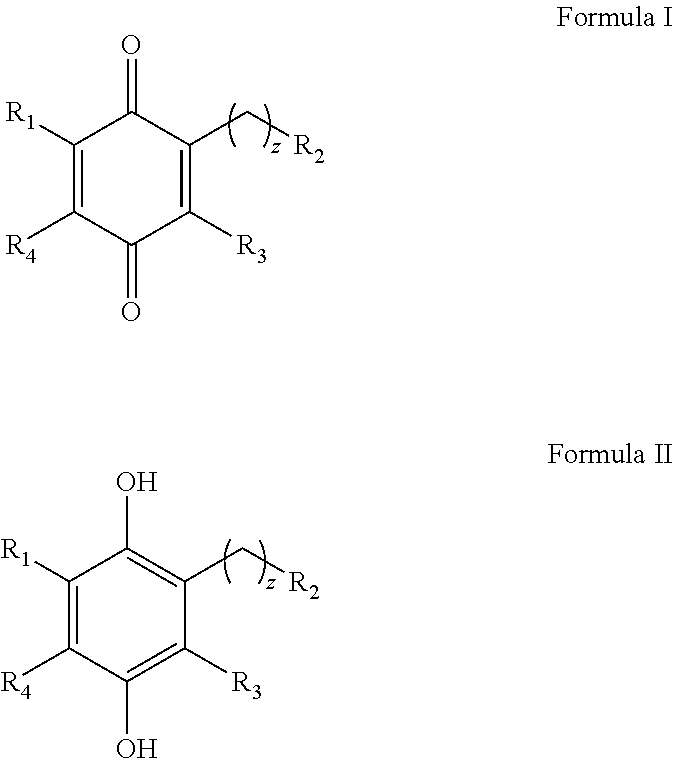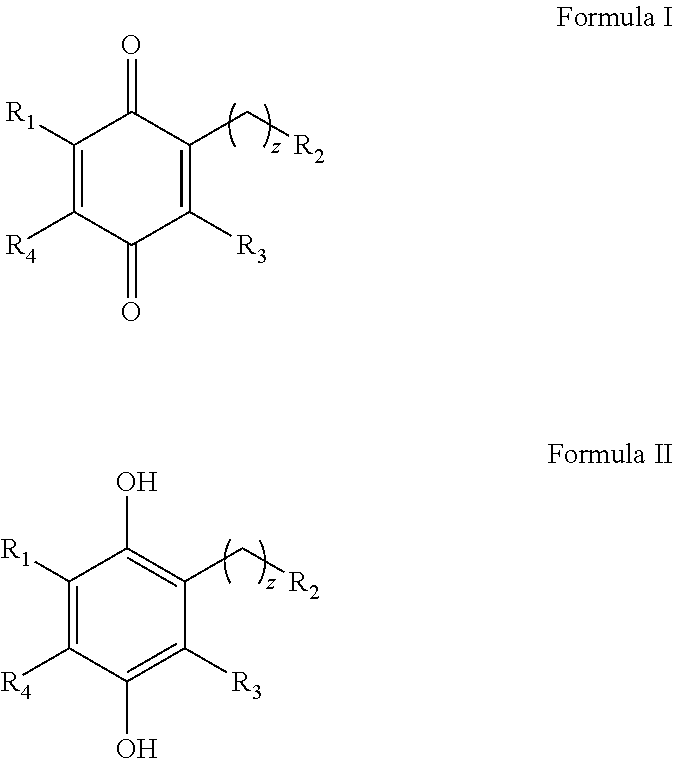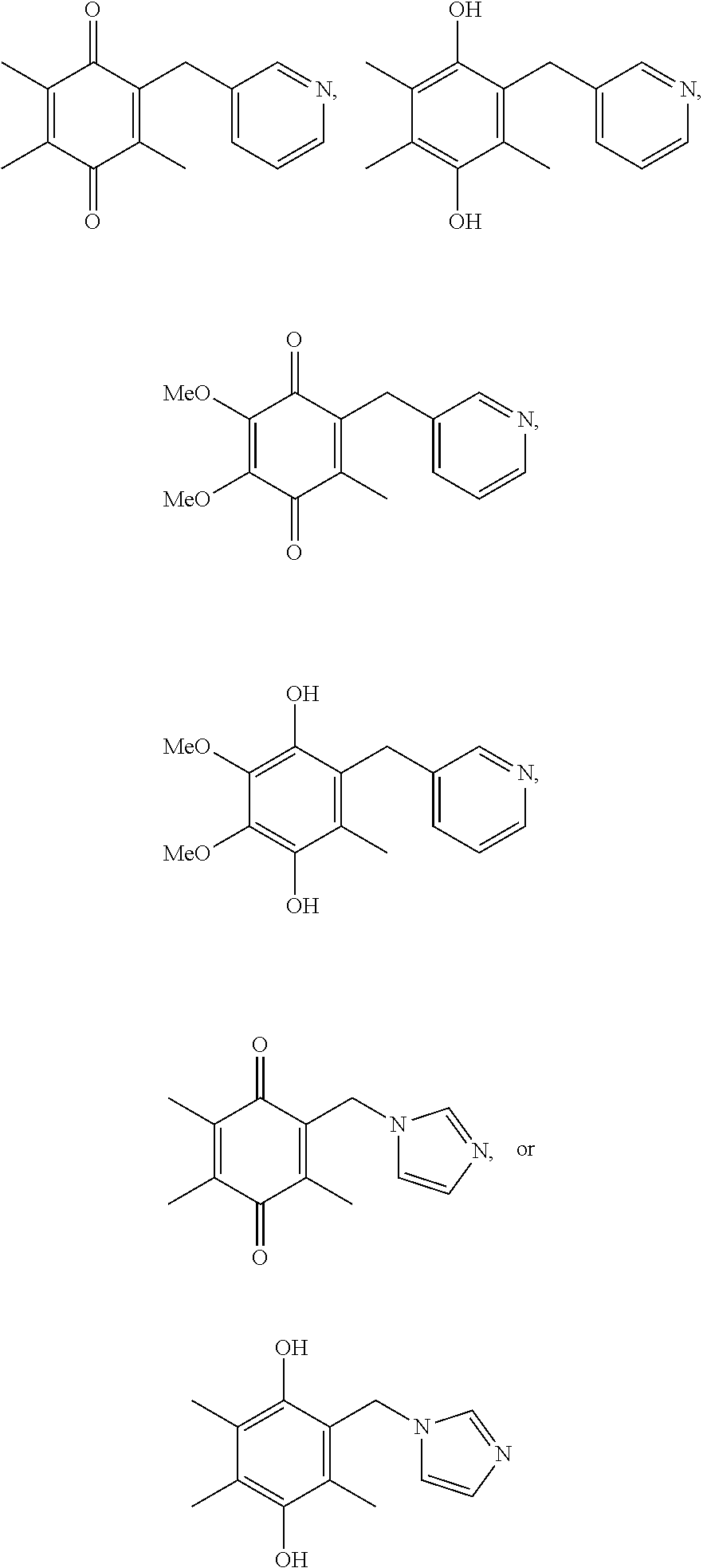Alkyl-heteroaryl substituted quinone derivatives for treatment of oxidative stress disorders
- Summary
- Abstract
- Description
- Claims
- Application Information
AI Technical Summary
Benefits of technology
Problems solved by technology
Method used
Image
Examples
example a
Synthesis of Compounds
[0128]50 mg of the following compounds are synthesized at >95% peak purity by HPLC with 1H NMR analysis in accordance with the above described synthetic schemes. Compounds are purified by prep-HPLC (formic acid counterions only), and are delivered as lyophilized powders.
example b
Synthesis of N-Linked Heteroaryl Compounds of the Invention
[0129]An exemplary synthesis of an N-linked heteroaryl compound of the invention is shown in the scheme below.
[0130]A solution of compound 1 (30 g, 197 mmol) in ethanol (200 mL) was cooled in an ice-water bath and degassed with a steady stream of hydrogen gas for 10 minutes until a clear, brown solution formed. A degassed solution of 10 M NaOH (41.6 mL, 416 mmol) was added dropwise over 2 min under positive hydrogen pressure, during which time a thick brown slurry developed. Over 5 hr, the reaction mixture was allowed to warm to room temperature. Saturated aqueous ammonia solution (150 ml) was added and the resulting mixture stirred for 15 min to quench excess reagent. The mixture was transferred to a separatory funnel and extracted with MTBE (2×400 mL). The combined organic layer was washed with brine (50 mL) and the dark red solution was dried over anhydrous sodium sulfate, filtered, and concentrated in vacuo. The resultin...
example c
Synthesis of C-Linked Heteroaryl Compounds of the Invention
[0137]An exemplary synthesis of a C-linked heteroaryl compound of the invention is shown in the scheme below.
[0138]To a solution of compound 3 (3.0 g, 14.4 mmol) in THF, cooled in an ice-water bath, was added a solution of allyl magnesium bromide (1.0 M in ether, 21.1 mL, 21.1 mmol) over 3 minutes. The reaction was allowed to warm to room temperature over 18 hrs before partitioning between 50 mL ethyl acetate and 25 mL water. The aqueous later was removed and extracted with ethyl acetate (2×50 mL). The combined organics were washed with brine (25 mL), dried over anhydrous sodium sulfate, filtered, and concentrated in vacuo. Purification by column chromatography afforded the product, which was characterized by HPLC-MS and 1H NMR.
[0139]A solution of compound 9 (2.5 g, 10.1 mmol) in dichloromethane (10 mL) was treated with triethylsilane (8.0 mL, 50.3 mmol) and cooled in an ice-water bath. To the resulting solution was added TF...
PUM
| Property | Measurement | Unit |
|---|---|---|
| Pharmaceutically acceptable | aaaaa | aaaaa |
| Stress optical coefficient | aaaaa | aaaaa |
| Disorder | aaaaa | aaaaa |
Abstract
Description
Claims
Application Information
 Login to View More
Login to View More - R&D
- Intellectual Property
- Life Sciences
- Materials
- Tech Scout
- Unparalleled Data Quality
- Higher Quality Content
- 60% Fewer Hallucinations
Browse by: Latest US Patents, China's latest patents, Technical Efficacy Thesaurus, Application Domain, Technology Topic, Popular Technical Reports.
© 2025 PatSnap. All rights reserved.Legal|Privacy policy|Modern Slavery Act Transparency Statement|Sitemap|About US| Contact US: help@patsnap.com



